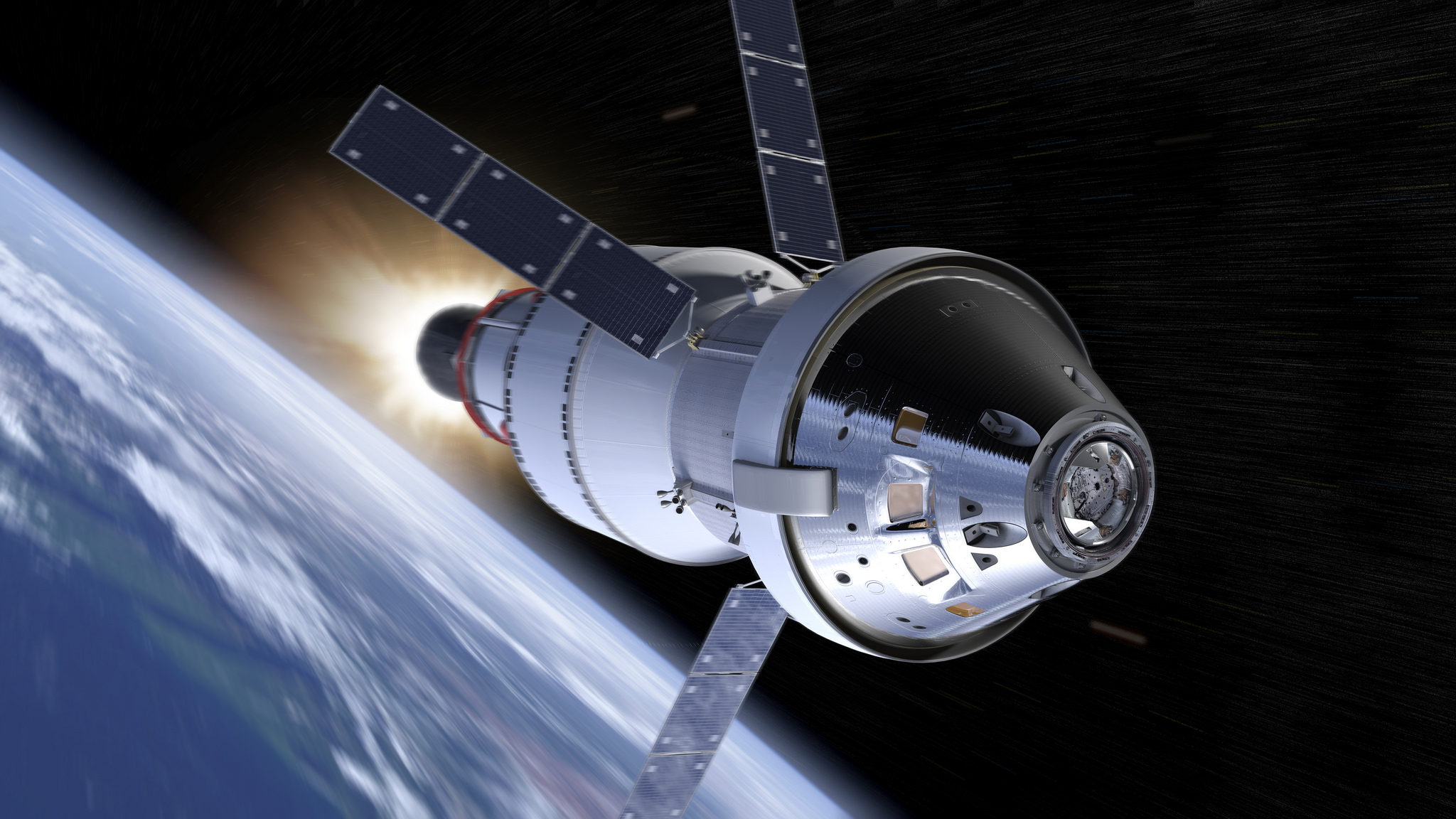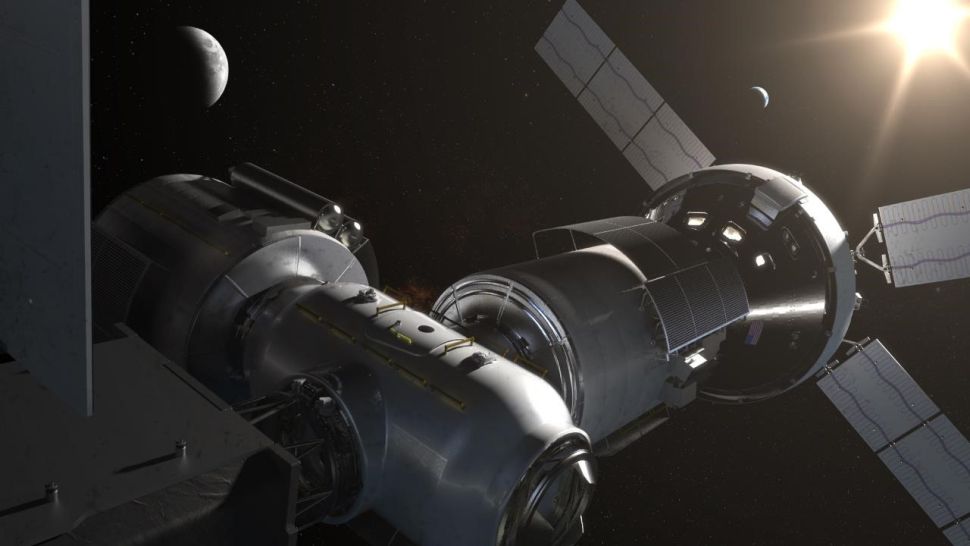NASA still aiming for 2024 moon landing despite SLS megarocket delays
The next nine to 12 months will be critical for the development of the landing system.

The first launch of NASA's back-to-the moon program has slipped into the second half of 2021, but 2024 remains the target for the first crewed lunar landing since the Apollo days.
In May 2019, NASA named its lunar return program Artemis, after the Greek deity who is both Apollo's twin sister and goddess of the moon. The program's first mission, Artemis 1, is an uncrewed flight test of the Space Launch System (SLS) megarocket and the Orion crew capsule. If all goes well, this duo will carry humans to the moon and back during Artemis 2 and Artemis 3, the final two missions of the program's first phase.
Artemis 1, which will mark the first flight of the SLS and the second of Orion, is currently over a year away, pushing back the November 2020 launch time frame that was previously announced by NASA Administrator Jim Bridenstine, as SpaceNews recently reported.
Related: NASA graduates new class of astronauts to join Artemis-era missions
Artemis 1 will send Orion on a trip around the moon. The flight test will demonstrate the performance of various key SLS and Orion systems, including the crew capsule's heat shield. The subsequent mission, Artemis 2, will be the first crewed test flight of SLS and Orion, bringing humans around the moon and then safely back to Earth. Artemis 2 is currently targeted for late 2022.
The endgame of the program's first phase (and its most anticipated chapter) is Artemis 3, which will put two astronauts on the lunar surface, near the moon's south pole. It will be the first crewed lunar landing since Apollo 17 in December 1972.
Last year, President Donald Trump's administration shortened Artemis 3's deadline considerably.
Breaking space news, the latest updates on rocket launches, skywatching events and more!
On March 26, 2019, Vice President Mike Pence announced that NASA's goal of returning humans to the moon by 2028 was "just not good enough," and then said the United States would do it by 2024. Pence made the remarks at the fifth meeting of the National Space Council, held at the U.S. Space and Rocket Center in Huntsville, Alabama.
Many in the spaceflight industry were surprised, including NASA associate administrator Steve Jurcyk.
''The vice president announced that we were going back to the moon with astronauts by 2024. The day before, our plan was to return astronauts to the moon by 2028," Jurcyk said on Feb. 28 during opening remarks at the Lunar Surface Innovation Consortium hosted by the Johns Hopkins University Applied Physics Laboratory in Laurel, Maryland.
"So, that was interesting. We just lost four years of scheduling in about a 5-minute speech," he added.
But Jurcyk stressed that the NASA team and the space agency's university partners are ''excited'' and up for the challenge.
''All the elements to do this [phase] are in development, with one exception," Jurcyk said.
"The one element that we are this close to getting the development kicked off on is the human landing system," he said. "We are very close to awarding, likely, multiple contracts, one or more contracts, for the human landing system within weeks," he later added.
The landing system would include a transport element in the form of ascent and descent vehicles that could get crew from the proposed orbiting moon outpost, called the Lunar Gateway, down to a low lunar orbit.
Related: Want to go to the moon? NASA is now taking new astronaut applications.
The next nine to 12 months are going to be critical in the development of the landing system, Jurcyk said.
''We got study contracts with a dozen of our industry partners on the landing system already, and those are wrapping up and we're going to move to a down-select," he said. Over the course of this year, NASA will nail down landing-system requirements and enter preliminary design review, Jurcyk added.
Every other part of Artemis Phase 1 is already underway, he said.
Artemis is designed to pave the way for crewed trips to Mars, which NASA aims to pull off in the 2030s. Jurcyk touched on one important long-duration feature during his Feb. 28 presentation: having a closed-loop system.
Over the last two decades, crewmembers on the International Space Station have spent a lot of time repairing and replacing environmental control and life-support systems, he said. The reliability of these systems needs to improve, Jurcyk said, and Artemis needs to get to a closed-loop system, "where we are recycling everything back in … We need to improve our reliability if we are going on a one- [or] two-year trip to Mars." Orion does not currently have a closed-loop system, but NASA hopes down the road that the Lunar Gateway will.
Another possible challenge involves ensuring that NASA's communications infrastructure is ready to support the crewed missions of Artemis 2 and 3. At the end of Jurcyk's presentation, an audience member shared a concern that the agency's Deep Space Network (DSN), which NASA uses to communicate with its various spacecraft, might be heavily taxed with the addition of Artemis responsibilities. Jurcyk responded that this concern recently came up in a meeting about Artemis 2.
''We are definitely going to upgrade and evolve the current DSN infrastructure, and those plans are in place … This is a gap right now, and we are going to fill it really quickly," not only by working across the mission directorates, but by also collaborating with industry and international partners, Jurcyk said.
- NASA plans to build a moon-orbiting space station: Here's what you should know
- Record-breaking NASA astronaut welcomes decade of Artemis with stunning moonrise photo
- NASA has a plan for yearly Artemis moon flights through 2030. The first one could fly in 2021.
Follow Doris Elin Urrutia on Twitter @salazar_elin. Follow us on Twitter @Spacedotcom and on Facebook.
OFFER: Save at least 56% with our latest magazine deal!
All About Space magazine takes you on an awe-inspiring journey through our solar system and beyond, from the amazing technology and spacecraft that enables humanity to venture into orbit, to the complexities of space science.

Doris is a science journalist and Space.com contributor. She received a B.A. in Sociology and Communications at Fordham University in New York City. Her first work was published in collaboration with London Mining Network, where her love of science writing was born. Her passion for astronomy started as a kid when she helped her sister build a model solar system in the Bronx. She got her first shot at astronomy writing as a Space.com editorial intern and continues to write about all things cosmic for the website. Doris has also written about microscopic plant life for Scientific American’s website and about whale calls for their print magazine. She has also written about ancient humans for Inverse, with stories ranging from how to recreate Pompeii’s cuisine to how to map the Polynesian expansion through genomics. She currently shares her home with two rabbits. Follow her on twitter at @salazar_elin.



